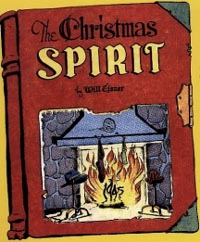|
GENRES:
General fiction; crime & mystery fiction
AUDIENCE:
Adults, teens, kids; a few guns go off, but nothing much happens
beyond that
NOTE: This book won the 1995 Eisner Award (appropriate, eh?)
for Best Archive.
SYNOPSIS:
This book collects what were presumably the best of the Christmas-related
stories about Eisner's great creation, the Spirit. Spanning 1940
to 1951 (but skipping 1942-1944), the nine stories within only
use the Spirit peripherally, as he doesn't fight crime on Christmas,
preferring to let the "Christmas spirit" take care
of things.
- "Black Henry and Simple Simon" is the story of
two crooks who rob the "Paupers National Bank." Invited
into a church by a priest who bears a strong resemblance to Santa
Claus, the two baddies are overwhelmed by the poverty of a poor
child who eagerly anticipates his first taste of chicken and
his first-ever presents (the money at the bank was intended for
that purpose). The crooks return the money to the bank.
- "A Trilogy" concerns "three wise tramps"
who discover that the king of the hobo jungle is a bitter young
boy with one leg. To soften King Hobo, the three tramps tell
tales of Christmas and the minor miracles that happened to them
on that day. After the young boy falls asleep, the tramps collect
money to buy him a gift. King Hobo is so touched that he goes
to the Spirit to return money that he stole. The Spirit invites
him to share Christmas with him and his friends.
- "Horton J. Winklenod" is a wealthy man who still
believes in Santa Claus until other men tell him differently.
The millionaire, despondent, promptly vanishes. Two minor criminals
find him almost frozen to death in the snow. Gleefully, they
plan to ranson him for $5,000 and dump him in the basement near
a fireplace. Lo and behold, Santa comes down the chimney. The
millionaire is so happy to see Santa that he gives the criminals
the money they wanted.
- "A Fable" is the fable-like story of three ambassadors
who cannot agree on peace terms to end the war. One ambassador
is knocked out by a snowball and found by two criminals, who
take the man to the Octopus, "the greatest criminal in the
world." The Octopus wants the ambassador to continue to
block the Allied consolidation and promises to supply millions
of men to rekindle the war. Torn, the ambassador slips out. Meanwhile,
another ambassador is knocked out by a snowball; he wakes and
speaks with a despondent department-store Santa, who hates giving
out war toys as presents and has gone on strike. As a result
of these experiences, all three ambassadors promote peace at
the peace conference, and the world gives up war forever.
- "Joy" is a misnamed orphan boy in a war-torn country.
Scrounging for food, he encounters a starving old man, and Joy
gives the man his last bit of bread. The man calls himself Santa
Claus and promises to grant Joy's wish. Joy wishes to be "in
a land where the cities are not smashed and the buildings stand
tall and clean... where there are big stores filled to the seams
with toys and food and warm clothing...." But nothing happens,
so Joy falls asleep. The old man carries the boy to an airfield
and transfers his visa to the boy. Joy wakes up in the United
States.
- "Basher Bains" is a prisoner who hates Christmas.
Santa arrives and gives Basher his freedom, as well as his Santa
suit to wear. Though Santa expects Basher to return, the convict
has no intention of doing that. He digs up the loot he stashed
away before he went to prison. But as he's about to go off and
kill the Spirit for locking him up, three children come up to
him and ask for their present. Basher yanks off his beard to
show them he's not Santa, but one of the kids can't see--he's
blind, and the present they were hoping for is an operation to
restore his sight. Humbled, Basher takes the kids to a doctor,
hands over the money, and goes back to his cell.
- "S. Kringle Klaus" has come to the city to make
lists of what people want for Christmas. A snowball to the head
removes his memory; he wanders the streets trying to recall his
purpose. Two crooks blunder into him (hitting him on the head)
and, fearful of being caught, carry his unconscious body with
them. Santa wakes recalling everything, and after convincing
the thugs of his identity, he enlists their help in handing out
gifts.
- "Darling's First Christmas" tells of a very wealthy,
very unpleasant little girl, Darling O'Shea, who has never received
a gift. Curious as to why poor children seem to be much happier
than her, the sycophantic adults around her explain about the
concept of gifts and Santa. Though she views gifts as "charity,"
she nevertheless writes Santa a long legal letter demanding one
(1) gift this year. Receiving no answer, she hires men to guard
every home in the city and prevent Santa from giving anyone a
gift. "Shoot to kill!" she insists. However, Santa
arrives that night--he'd been unable to approach her before because
of all the guards surrounding her in previous years--and gives
her several years' worth of gifts. As he leaves, shots ring out!
But no one is hurt, and Darling is happy.
- "Joe Fix" is approached by a mysterious man who
demands that Santa not give out presents this year. Joe promptly
embarks on a smear campaign that turns the jolly old elf into
an evil villain, and Santa decides not to appear. But when Joe
gleefully looks at the million-dollar check given him by the
mysterious man, he sees the name "Lucifer Mephistopheles."
Realizing he's been tricked into doing the Devil's work, he gives
his check to Santa, who embarks on his annual mission after all.
The book begins with a short introduction by Eisner (who is
Jewish, of course) about his rationale for writing these stories.
EVALUATION:
It's disappointing when I read something like this by one of
the seminal figures in comics (hey, he invented the term "graphic
novel," which makes him a demi-god in my eyes, at least).
As might be evident by the synopses, these are secular, slight,
wistful, occasionally creative, mostly saccharine stories that
are only peripherally indicative of Eisner's storytelling talent.
Of course, Christmas stories in general are like that, and these
pieces are taken out of context--they were, of course, framed
by standard Spirit stories, so the saccharine didn't go into
overdose when they were first published. Still, the blurb on
the back of the book promises more than the stories deliver,
claiming that they're "filled with insights into the human
spirit." To employ a Yiddishism: balt. (It's a polite
way of saying "bullshit.") These stories are about
as insightful as greeting cards. But I shouldn't hold marketing
twaddle against Eisner, whose introduction expresses a sincere
admiration for that mythical thing called "Christmas spirit"
and whose stories attempt to capture it, however simplistically.
Actually, this book is more interesting to me for its incidental
depiction of the evolution of Eisner's artistic and narrative
style. The first story (1940) is crude; the characters barely
resemble the figures we've come to know and love, and the visuals
are conventional. A year later, Eisner had begun to experiment
with alternative forms, going outside the traditional panels
a little, though still feeling his way around the regular characters.
The jump to 1945 takes us into an era where Eisner obviously
had become much more confident with both his art and his storytelling.
The stories peak from 1946 to 1950. 1951, however, is pretty
bad, because the style simply isn't Eisner's, despite his name
on the story. I'm no Eisner historian, so I'm wondering if it
was "ghost-drawn" by someone else. Two other artistic
problems: these stories were taken directly from the old newspaper
versions, so they're often very grainy; and in several of the
stories, the word balloons sometimes point at the wrong characters.
According to the book, much of this material has never been
collected before (I've seen "Basher Bains" elsewhere),
so for that reason alone it deserves a place on the shelves of
Eisner aficionados. As a Christmas book, it's as good as any
other, storywise, and vastly superior (for the most part), artwise.
However, for people wanting to be introduced to the master, this
book isn't the place to start. Also, a word of warning: most
of the stories use the (to put it kindly) broadly drawn character
of Ebony, whose personality and the Spirit's treatment of him
may have transcended stereotypes, but his appearance and dialect
(especially in brief) sure don't. In historical context it's
tolerable, but I can see it offending people who just glance
at the book. Anyway, the book is out of print, but if I could
get one, you can too. (Hooray for the Internet!) |



